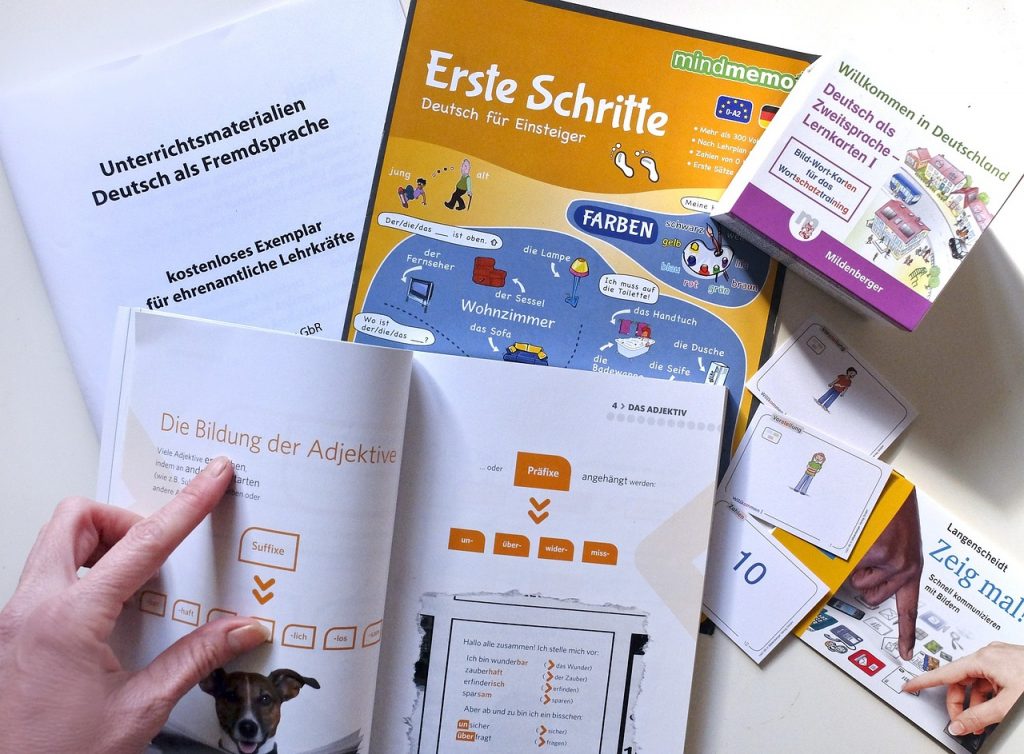Get Your German Off To A Flying Start! 9 Tips Posted by Constanze on Jan 9, 2019 in Language
Guten Tag (Hello)! And, if this is your first time on Transparent Language, WILLKOMMEN (Welcome)! With a new year comes a fresh start, and with many people making new year’s resolutions, learning or brushing up on a language is often one of them. If you’ve decided to learn or brush up on your German this year, here are 9 things you need to know about the German language that will get you off to a flying start.
German is part of the same language family as English.
Both German and English are West Germanic languages. That means, although there are significant differences between the languages, there are also several similarities that will give you a heads-up as you go along your German language journey. For instance, there are many German words (Arm, Knie, Hand, Finger, Haus, Maus, Papier, etc.) that are easy to take a guess at if you know English! But beware- there are also many false friends, as you will see in point number 2, below.
German and English have many ‘false friends’!
False friends are words that are spelt the same in two languages, but have different meanings. One example is the word bald, which exists in both German and English. If you know the English meaning you might assume it means the same in German – but it doesn’t. In German, the word bald means soon – something completely different. You will come to know these false friends very well!
Read about false friends here.
The German alphabet has 4 more characters than the English one.
The German alphabet is exactly the same as the English alphabet. The only difference is that it contains 4 extra characters. These are ä ö ü (Umlaut) and ß (Eszett). Get to grips with these characters early on – here are some blog posts that might help:
Read about the Umlaut here.
Read about the Eszett here.
All nouns are capitalised in German.
When you see German for the first time, you might wonder why sooo many words in a sentence have capital letters. This is because all nouns are capitalised in German, not just names and places. A chair (der Stuhl), a cat (die Katze), a mobile phone (das Handy) and a hoover (der Staubsauger) are all capitalised, all the time! This is good because it helps you to recognise nouns in a sentence.
There are three words for ‘the’ in German.
These are der (masculine), die (feminine) and das (neuter). Although this might seem confusing at first, there are many hints and tips to let you know which word takes what article!
About masculine nouns.
About feminine nouns.
About neuter nouns.
Tips for learning noun articles here.
Learn every noun with its article.
Following on from the above: One excellent way to get to grips with a word’s article is to learn the noun and its article together. So when you learn the word ‘chair’ in German, it’s always der Stuhl and never just ‘Stuhl’. Treat the article as part of the word to speed up your learning.
There are two ways of saying ‘you’ in German.
There is the informal, casual ‘you’ used with friends and family, and the formal ‘you’ used in professional situations and with people you don’t know. This might seem confusing at first, but it’s actually pretty straight-forward.
Read about the two types of ‘you’ in German here.
A lot of German words are very literal and simple.
As complicated as it might seem at times, German can be beautifully simplistic and straight-forward. For example: A skunk in German is das Stinktier – ‘a stink animal’. A hoover is der Staubsauger – ‘a dust sucker’. On those days when German seems massively complicated, seeing a straight-forward word like this can really put a smile back on your face!
Read about German’s simple words here.
There are hardly any silent letters in German.
This is pretty self-explanatory, but might take some getting used to! For instance, if a word ends in an e in German, that letter e is pronounced. One example is the word der Hase (rabbit), which is pronounced Hah-seh. The letter k is often silent in English, but not in German: das Knie (knee) is pronounced with a hard K. What’s good about this is that it means most words are pronounced exactly how they look!
Read more about silent letters in German (or lack thereof) here.
I hope these 9 tips and the linked blog posts have given you the tools you need to go confidently into your German language learning journey! If you have any questions, feel free to leave a comment below. Viel Glück (good luck) with your German language practice! 🙂

Build vocabulary, practice pronunciation, and more with Transparent Language Online. Available anytime, anywhere, on any device.







Comments:
ely setiawan:
i am from indonesia, this is very good information,
Constanze:
@ely setiawan Very glad to hear it! 🙂